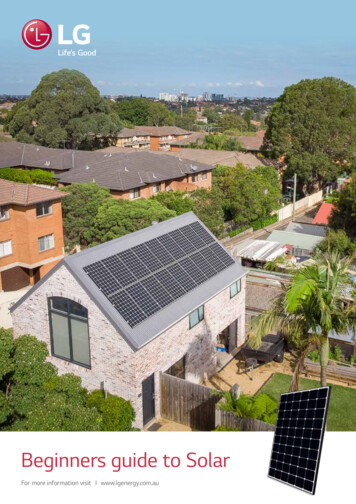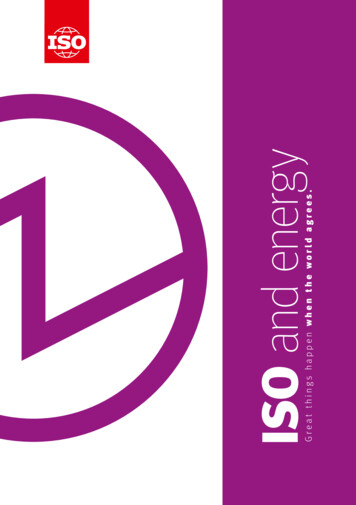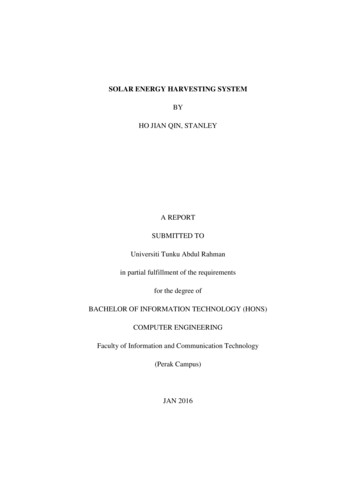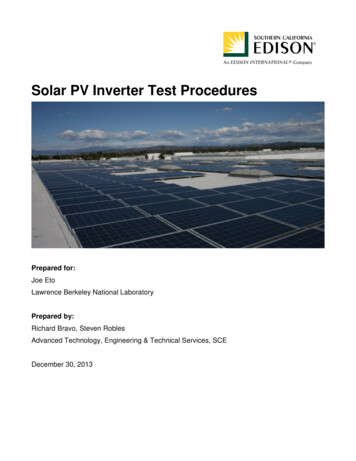
Transcription
Beginners guide to SolarFor more information visit I www.lgenergy.com.au
TABLE OFCONTENTSWhy You Should Choose a Solar System3The Benefits of Going Solar4How a Grid System Works5The Components of your Solar System6Solar PanelsInverter SolutionsBatteriesMounting SystemsMetering your Solar SystemYour Solar System SizeMeasuring how your components perform. The Difference between kW and kW/hInstalling PV Panels for your Solar SystemTilting and OrientationDaily RoutineShadingMountingInstalling Panels for Great PerformanceHow Long Solar Systems Last66777889999101011Solar Panel Sizes12Incentives, Rebates and Financing13Are There Rebates Available for Your Solar System?What are STC Certificates?What are Feed in Tariffs?Payment Plans13131313Details on How to Choose a Solar Installer14Questions to Ask Before you Buy15Additional Tips to Avoid Poor Quality Solar Equipment162 Beginners guide to solar www.lgenergy.com.au
WHY SHOULD YOUCHOOSE SOLAR?Over the past five years,the cost of installing a solarsystem has reduced. Solarenergy used during the day,and soon with batteriessupplying electricity at nightcan generate significantsavings by reducing yourelectricity bill.Consumers of electricity who do not have solar systems are going to pay fortheir electricity indefinitely. In regards to electricity consumption, users arelike a tenant who will keep on paying indefinitely for the accommodation.By owning a solar system you typically own a big share of the electricityyou consume, with the savings you make immediately starting to payoff the cost of your investment. For many homes in about five to sixyears, your power savings will have paid off the investment you spent.With a top LG solar system you will join the hundreds ofthousands of home owners across Australia and the world whohave already chosen LG solar panels and you and your familywill continue to save on electricity bills for years to come.To help you select and install your solar system, a certified LG installer will guide youthrough the process from the moment you first consider solar panels to the planningand installation phases of your home or business solar system. You can find an installerwho will supply a free detailed quote via the dealer search at lgenergy.com.au3 Beginners guide to solar www.lgenergy.com.au
THE BENEFITS OFGOING SOLARSo, what are the benefits of a residential solar system?1. Solar Power can save you money – Installing Solar powerenables you to generate your own electricity. By using yourown electricity rather than buying it from your electricitycompany, you will save money as every kW/h of electricityyou use from your solar system is a kW/h of electricityyou do not have to buy from your electricity company.4. Property Value – there are studies that show that installinga quality residential solar system may increase the value ofyour home. Home buyers are increasingly recognising thata home with quality solar panels installed will have lowerelectricity costs. -solar-panels-boost-property-prices/2. Environmental Benefits – By using electricitygenerated from solar panels, we reduce the need togenerate electricity from fossil fuels like coal and gaswhich create carbon dioxide (CO2). This can reduce thepotential for global warming and can create a moresustainable cleaner energy mix, this effect is evenstronger if your solar system lasts a long time.5. Energy reliability – High quality solar power systems area reliable power source. The sun rises and sets every day,while the sun shines, solar panels will generate electricity.While the weather and the seasons vary, the amount ofelectricity that the panels generate is predictable. You canalso increase the financial benefits of your solar system bychanging the times you operate your household appliances.For example, turning your washing machine on as youleave home in the morning and avoiding washing yourclothes at night allows your solar system to power yourwashing machine during the day. With the help of lithiumion batteries, which are becoming more affordable, you canalso store solar power during the day and use it at night.3. Energy Independence – By owning your own solarsystem, you have the capacity to create your ownelectricity. This reduces your reliance on the electricitygrid and electricity retailers etc and increases your controlover your future electricity needs, expenses and lifestyleespecially if you add batteries to your system in the future.To assess your energy usageprofile and discover thebenefits that you may derivefrom a solar system, talk toone of the LG AuthorisedDealers froman LG Dealer Searchon lgenergy.com.au
HOW A GRIDSYSTEM WORKSA solar system is made up of multiple solar photovoltaic (PV) panels, a DC to AC powerconverter (inverter solution) and a framing system to hold the PV panels in place.PV panels are generally fitted on the roof facing annortherly, easterly or westerly direction, and tilted at aparticular angle to maximise the amount of sunlightthat each panel receives.Ask your authorised LG Energy Partner for advice onwhich of these inverter solutions offer the most suitablesolution for you. Quality inverter/micro inverter solutionsinclude Fronius, SMA, Solaredge and Enphase brands.Suburban homes in Australia and New Zealand areconnected to the electricity grid via power lines. Ourelectricity system uses 240V alternating current (AC),but the electricity generated by solar panels consists ofvariable direct current (DC). To transform the DC electricityinto AC electricity for ordinary household use, grid-connectedsolar PV systems have inverters attached to each PVpanel called micro inverters or a single inverter for a stringof connected PV panels called a central string inverter.Today houses with grid-connected solar systemsconsume solar-generated electricity first, beforeswitching to the electricity grid if more electricity isrequired than the solar system is able to generate.The third possible inverter solutions are poweroptimisers, which are a variance of the stringinverter and the micro inverter. All these technicalsolutions can create a great solar system.Grid-connected solar systems can also feed electricityback to the grid if too much electricity is generatedvia the solar system for the immediate needs ofyour home. For information on rebates and rewardsassociated to feed-back electricity see page 13.Unless you add storage batteries to your system,a grid-connected solar system is unable tostore power in your home for use at night.GRID CONNECTED HOMEWITHOUT R ENERGYEXPORTEDACELECTRICITY METERACSWITCHBOARDGRID CONNECTED HOMEWITH BATTERIESSOLAR ELECTRICITY USED IN GERBATTERIESACACGRIDSOLAR ENERGYEXPORTEDACELECTRICITY METER5 Beginners guide to solar www.lgenergy.com.auACSWITCHBOARDSOLAR ELECTRICITY USED IN HOUSE
THE COMPONENTSOF YOUR SOLAR SYSTEMWhat makes up a solar system?A solar system is made up of a number of key components, all of which combine to generate electricity, regulateand control the flow of the electricity and to connect and mount the solar system to your building. A gridconnected solar system comprises of panels, a string inverter or micro-inverters or optimisers, a roof mountingsystem and electrical accessories including circuit breakers and wires. It is important that all components worktogether, with no component compromising the performance, safety or life expectancy of any other component.SOLAR PANELSSolar PV panels on roofs ofhomes and businesses generateclean electricity by convertingsunlight into usable electricity.This conversion takes place withinthe solar cells and is a processthat requires no moving parts.325 to 335W350 to 365WINVERTER SOLUTIONSA solar inverter is one of the mostimportant elements of the solar system.It converts the variable direct current(DC) output of a photovoltaic (PV)solar panel into a 240V alternatingcurrent (AC). This AC electricity canbe fed into your home to operateyour household appliances.ENPHASE MICRO INVERTERSOLAR EDGE INVERTERSMA INVERTERDepending on how your system isset-up the electricity that is not usedin your home is either fed into the gridvia a digital meter or stored in homebatteries for later use. New hybridinverters now include an integratedbattery management system.Long lasting solar systems for theAustralian climate require highquality inverters. Unfortunately, lowerquality inverters and panels havefailed to perform under Australianconditions in large numbers andfailed in as little as 2 years.LG CHEM BATTERIESFRONIUS INVERTERS
BATTERIESSince 2015 solar storage batteries have reduced steadily in cost to thepoint that pay back for many households is coming down from more than10 years towards 7 years and less. At LG we believe that in future yearsmost residential solar systems will include a battery as part of the solarsystem package. Discuss with your LG Energy Partner if batteries are feasiblein your circumstances, or if you should get a “battery ready” system.MOUNTING SYSTEMSSolar systems are mounted to roofs with a mounting system usingvarious railings, frames and tiles or tin feet. Most mounting systemsare made of aluminium with stainless steel hardware and are designedto accept a variety of solar modules on a variety of roof types.Aluminium rails with clamps attach the solar panels to the rail andconnection brackets fix the rail to the roof (see diagram below).Superior mounting systems are manufactured with higher grades ofaluminium and stainless steel, often resulting in less weight on theroof and lower levels of corrosion over longer periods of time. Qualitymounting rails may also feature robust anchoring points and designsolutions that speed-up the installation time of your solar system.Purchasing a strong and well-engineered mounting system is the sensibleway to protect the investment you have made in your solar system as theywill be more rigid. The standard mounting frame warranty is 10 years.METERING YOUR SOLARSYSTEMThere are two fundamental stepsto take when connecting yoursolar system to the gridStep 1. Your electricity networkcompany will specify what type ofmeter is required to measure your solargeneration and energy consumption.Your LG Energy Partner will be ableto explain the details to you. You maybe required to pay for the cost of thenew solar meter and its installationin addition to the cost of your solarsystem. Prices can be a few hundreddollars, so you should make sure thatthe solar electricity meter supplyand connection is included in thequote for your new solar system.Step 2. Shop around for a competitiverate for off-set and exported electricityfrom your solar system with yourelectricity retailer. This is called a ‘feedin tariff’ (FIT) and varies by retailerand location. Some electricity retailersmay offer a low FIT. If your existingelectricity retailer does not offer anattractive solar FIT, you may wish toconsider changing your retailer to aretailer who does. Your solar systeminstaller will be able to advise you onwho offers the best FIT in your areaand assist you with the process.CLIP MOUNTING7 Beginners guide to solar www.lgenergy.com.auWe recommend youonly use quality panels/inverter solutions forlong lasting systems
YOUR SOLAR SYSTEM SIZEYour LG solar system is rated according to the number of Wattsit can produce per hour. This rating is rarely achieved in full duringreal life conditions as dust particles, clouds and other naturalissues will affect the quality of light that your PV panels receive.For example 16 x 330W solar panels will create a 5,280 kW solarsystem. In regards to overall system output on an average daywith intermittent clouds this system will produce approximately3-4 kW per hour in the best sun irradiation hours of the day.The system will only achieve 5kW per hour on a very sunny day,in the middle of the day and clear sky, for example after rain.MEASURING HOW YOURCOMPONENTS PERFORM.THE DIFFERENCEBETWEEN KW AND kWhkW stands for kilowatt or 1,000Watts and is a measure of powerkWh stands for kilowatts per hourand is a measure of energy* In 2016 LG panels won the prestigiousIntersolar Award and in 2016, 2017and 2018 the prestigious Top Brand Award.LG Panels look fantastic on your roof.A smart looking home is a more valuable asset.Invest in LG panels for better long term outcomes.LG PANELS25kWh – The average residentialhousehold’s daily consumptionCONVENTIONAL PANELSElectricity bills are usually measured inunits of kWh. Solar Panels aremeasured in Watts. E.g. LG Neon 330WA 1 kW electric poolpump used for onehour will consume1 kWh of electricityTwenty x 50W downlights used for anhour will consume1kWh of electricity(20 x 50 1,000)8 Beginners guide to solar www.lgenergy.com.au
INSTALLING PVPANELS FOR YOURSOLAR SYSTEMTILTING AND ORIENTATIONSolar modules can face anywhere from the East to the North and the West,while still providing good output performance.In Australia, a grid-connected solar system will generate the most solarelectricity when the LG solar panels are facing north at a tilt angle of 15 to30 degrees. But with the introduction of time of use metering by electricityproviders in Australia, a north-west or fully western facing solar system maygive a more positive financial outcome.Time of use metering is when energy retailers charge more for their electricity(approximately 45 cents per kW/h or more) in peak usage periods, forexample weekdays from 2pm until 8pm. During these times Western facingpanels will produce a greater amount of solar electricity, therefore creatingbetter savings.Discuss with your LG Authorised Partner your electricity usage, so that yourusage pattern can be matched with your solar panels installation direction.Of course the setup of your roof also plays a major role where the panels canbe installed.DAILY ROUTINEThinking about your daily routine and your electricity consumption will helpyou locate the best possible position for your solar panels. If lots of electricityis used in the morning, an easterly roof will offer the best benefits. If lots ofelectricity is used during the middle of the day, we would advise a north facingroof and if lots of electricity is used in the early and late afternoon a northwest facing roof is more likely to offer the best outcome. With multi-stringinverters you can also put one group of solar panels (one string) on the eastand one on the west to cover a wider time-span.SHADINGThe amount of electricitygenerated by your solarsystem directly relates to theamount of sunlight that yourPV panels receive. The moreyour solar modules are coveredin shade, the less electricityyour system will generate.Even a single antenna or achimney shadow on your panelscan affect performance, whilethe overall effectiveness of yoursolar system is dependent onwhere you live. In some areasof Australia (for example, theBlue Mountains near Sydney)over 20% of homes havereduced suitability for solarsystems due to extended treecoverage close to the home.Using micro-inverters or poweroptimisers on each panel, insteadof one large string inverter(where multiple panels areconnected to one inverter) canhelp with shadow issues. Witheach individual panel managed toachieve its maximum electricityoutput individually, the lossesassociated to shade can bereduced by as much as 25%.If you believe that you mayhave a shadow issue, talk toyour LG Energy Partner andcheck if power optimisersor micro-inverters are apotential solution for you.9 Beginners guide to solar www.lgenergy.com.au
MOUNTINGIf a suitable roof area is not available at your home, LG solar panels can be fitted to a ground-mountedsystem in a sun-filled spot on your land.However, you will need to allow for additional costs for a ground mounting system, including costs forrunning the cable safely in the ground. These options can be discussed with your local LG solar dealer.INSTALLING PANELS FOR GREAT PERFORMANCELG is confident that our panels willgive you years of reliable functionality.As of March 2018 only 10 panelshave needed to be replaced fromover 550,000 panels installed acrossAustralia since 2011. Although thecables, safety devices and mountingsystems are less influential to theperformance of your solar system,the use of poor quality cables orisolators can lead to premature systemfailures. In cases where non-brandedplugs and cables were used, completesystem failures have occurred.For a decade of low maintenanceto your solar system, it is stronglysuggested that you purchase highquality solar panels, quality solarinverters and ask for a qualitybalance of system components inall aspects of your solar system.Some cheap solar panels have failedin the Australian and NZ climate in aslittle as 24 months. Typical issues havebeen water ingress, corrosion, hotspots, failed bypass diodes or junctionbox failures. These type of failures leadto the write off of the panel. Oftenthe lengthy promised warrantiesare hard to claim when dealers,installers or panel manufacturershave gone into liquidation or havestopped operating in Australia/NZ.10 Beginners guide to solar www.lgenergy.com.auElectricity bills are usuallymeasured in units of kWh.Solar Panels are measured inWatts. E.g. LG Neon 320WOver 560 solar installationcompanies have gone intoliquidation since 2011*.If you select a LG AuthorisedEnergy Partner you have aninstallation company that has gonethorough detailed vetting by LG.*Source: ASIC liquidated companies register
HOW MANY PANELS DOES YOURSOLAR SYSTEM NEED?An LG Authorised Energy Partner will visit your home for a siteinspection, checking the roof position, discussing your electricityusage pattern, discussing monitor options and, where applicable,conducting a shade analysis to ensure that the right quantity ofthe most suitable panels are placed in the optimum position.Buyers should insist that their installation company also undertakea physical site inspection. Many variables require consideration, withmany difficult to spot from satellite images or from aerial photosof your home. An installer's willingness to visit your home givessome indication as to the quality of service you will receive for yourpurchase. As a result, we advise that you buy your solar system froma local company and not an internet-based solar sales agent.Historically (when internet solar sales were rapidly increasing) consumerspurchased solar systems without site inspections. Sometimes this resultedin their installer highlighting the need for special roof brackets or a totalswitchboard upgrade before the solar system could be installed. Theseadditions added unexpected costs and time delays to the installation.Before making your purchase decision, check who your pointof contact is if you have questions after your installation.Make sure that you ask for a comprehensive written warrantyfrom the installation company for the cabling and installationwork, not just the panels, inverter and mounting frame.HOW LONG SOLARSYSTEMS LASTThe key components susceptible tofailure in your solar system are thesolar panels, the inverter and somecomponents like fuses and isolators.High quality solar products overall tend tohave longer life-cycles as they undertakemore quality control steps, use higherquality cells and solders, have stronger UVprotection on backing sheets and ensurethe water sealing of panels withstandsdecades of weather induced deterioration.Very low cost panels with less UVstabilised backing sheets, cheapersealants and more fragile framing candeteriorate faster and many have failedin Australia in as little as 2-4 years.Cheap inverter solutions also have higherfailure rates than quality solutions.Unfortunately sometimes lengthywarranties on cheap products have beenunobtainable as both manufacturersand installation company have avoidedliability by going into liquidation (e.g.Sunnyroo or Aearosharp inverters).In Australia over 560 installationcompanies have liquidated theirbusiness and likely escaped warrantyobligations since early 2011*.The key warranty for solar panels isthe Manufacturer’s Warranty. Highquality panels cover transport of thereplacement panel, the replacementpanel and the labour to take the failedpanel down and replace it. Cheaperpanels often do not cover transportand replacement labour. Make sure youenquire what is covered in the warrantyand ask for the detailed warrantydocument. Standard ManufacturersWarranties are usually for 10 years. Bycomparison, LG NeON 2 and LG NeONR panels have a 25 year warranty.11 Beginners guide to solar www.lgenergy.com.au*Source: ASIC liquidated companies register
SOLAR PANELSIZESSOLAR SYSTEM SIZE GUIDESMALL HOME1-2 People2-3kW SystemAv. production per day: 12 kWhMEDIUM HOME2-3 People3-4kW SystemAv. production per day: 16 kWhLARGE HOMEFOODBANK, WESTERN SYDNEY, 250KW LG NeON 2 SYSTEM4 People5-8kW System*This is a general guide ony and does not take your specific energy use requirements and practices intoconsideration. Please contact your LG Energy Partner for more detailed guidance on your solar system size.Av. production per day: 36 kWhWHY PANEL EFFICIENCY MATTERSCapacity of solar power system with20 panels (60 Cells per panel)7.3kWp365W NeON R Panel6.7kWp335W NeON 2 Panel5.4kWp270W Poly Standard PanelA few years ago many buyers ofresidential solar did not considerthe efficiency of their panels. If theywanted a 5kW system they couldbuy 20 panels with 250W or 23less efficient 220W panels. Mostcustomers never imagined they wouldin the future need more than 5kW ofsolar and in many homes around 20to 32 panels will fit on the roof. Thatwas the old solar thinking.With the emergence of batterystorage as a smart way to harvestthe light during the day and thento use this electricity at night,panel efficiency has become a veryimportant consideration. Consideringthat the future of electric cars iscoming fast, with Volkswagen forexample announcing many electric carmodels in the near future; you mightwant to expand your solar system inthe future to power your electric car.Worldwide CO2 emission reductioncould be enormous if we are able toutilise our roofs to generate more ofthe fuel for our cars. In short in thefuture one might want a 5kWsolar system for day use and 2kW12 Beginners guide to solar www.lgenergy.com.auof solar for the batteries to use atnight. Charging the car would requireanother 4-8kW of solar to power thecar(s). Overall suddenly there is theneed for a 10 -15kW system. With270W panels this would mean oneneeds to fit at least 40 panels. On theother hand, with the highly efficient365W LG panels one would need only29 panels.LG have now released a 360W and365W NeON R in the 60 cell rangeand a 405W panel in the 72 cellrange. This means if you can save 8spots now, with a higher efficientpanel – you can have another 3.6kWsolar system for your batteries orcars, which you would not be able tofit otherwise.So it is important today to buya system with future expansioncapability in mind, both for batteriesand future electric vehicles.Buy now with the needs of the futurein mind. Choose high efficient panelsand keep spare roof space for futureexpansion.
INCENTIVES, REBATESAND FINANCINGARE THERE REBATES AVAILABLE FOR YOURSOLAR SYSTEM?Rebates may be available for your solar system. Over the years theserebates have changed and may continue to change in the future. talking toyour nearest LG Energy Partner will give you updated information about thelatest rebates applicable to you.There is currently one key rebate offered for solar PV systems in Australiacalled Small Scale Technology Certificates (STCs). As per April 2018, thisrebate offered around 3200 towards a 5kW system, but the rebate amountcan change from time to time. When you see advertised sales prices forsolar systems, these prices usually have subtracted the rebate from the fullprice. The rebate will reduce every year in January, for the next few years.WHAT ARE FEED IN TARIFFS?Feed-in tariffs (FIT) are a defined payment for the electricity you generatefrom your solar system that is sent back to the grid. Currently energy retailersin most States pay FIT ranging from 9-12 cents. These FIT rates are based onstate guidelines and vary between electricity retailers. We recommend shoppingaround between retailers to determine the best available FIT rate for you.Some Energy Retailers sell solar systems and will tempt you with a highFIT. Please check that the overall electricity charges in such contractsare not higher than normal kWh charges, as your higher FIT incomemay be more than offset in higher electricity fees and charges.Previously around 2010, Australian solar system owners have benefitedfrom a range of generous “premium” FIT schemes. Unfortunately,these offers are no longer available with new solar installations.The value of a FIT is an important aspect to consider as it can influencethe economic outcome of owning a solar system and what theideal size of a system should be in your individual case. Good solarinstallation companies as part of their site visit should offer a detailedanalysis of what they expect your self-consumption to export ratioto be, and what economic outcome you will be able to achieve.Naturally if you install batteries with your solar system the FIT isless relevant.PAYMENT PLANSConsumers also have the option to finance a solar system. Oftenhomeowners redraw on their mortgage to finance the solar and batterysystem. Your installer can advise you about other available finance options.13 Beginners guide to solar www.lgenergy.com.auLG PANELS ARE ALSO USED IN MANYCOMMERICAL INSTALLATIONS IN AUSTRALIA.
DETAILS ON HOW TO CHOOSEA SOLAR COMPANYIt is recommended to use a reputable installation company that checks your specific solarsystem requirements. Please see the points below regarding the advantages of using acompany promoting high quality products.1A reputable solar retail company is more likely to fullyevaluate your requirements and explain in detail whatneeds to be done in order to install your solar system.2A local diversified company is more likely to be aroundin the future to service any warranty issues or systemupgrades. With some loud, marketing and price focused solarcompanies longevity of the company can be an issue.3If your installer is selling you LG solar panels, then in futureyears LG is very likely to be able to have a local companyservice your LG panels. If you choose an unknown brand, themanufacturer may go out of business or the importer maystop importing these panels into Australia. It is recommendedto buy branded solar panels from diversified manufacturerslike LG that have a sound track record in Australia.4A reputable solar company will be fully aware of currentelectricity supply rules as well as provide you advice on thebest feed-in-tariff. As a result, well established businesseswill be more likely to give you the most up-to date advice.5If your local installer belongs to the Authorised LGEnergy Partner network, then he/she has to install thesolar power system to a high standard and act ethicallyin their business dealings with you, the customer.*Source: ASIC liquidated companies register14 Beginners guide to solar www.lgenergy.com.auAll systems installed in Australia haveto be signed off by an accreditedsolar system designer/installer. Thefollowing elements are consideredwhen designing a solar system:a. Your current electricity consumptionand future needs;b. The available roof space and optimumpanel location;c. The orientation and pitch of theroof(s);d. Impact of shading across all seasonsand time of day;e. The structural soundness of the roof;f. Sizing the strings of panels forthe correct voltage of the invertersolution;g. Ensuring the design meets buildingcodes and electrical standards;h. Determining the most suitablelocation for the inverter and theway the cables are run;i. Considering appropriate monitoroptions and considering if batteriesare appropriate.
QUESTIONS TO ASKBEFORE YOU BUYAsking your solar installer a few essential questions may make a big difference to the serviceand benefits you receive. Make sure you get the answers in writing.1What is the estimated monthly and annualproduction in kWh of my system in itsinstallation position?5Who is responsible for connecting your solar PVsystem to the electricity grid? Is it the installer oranother subcontractor? When will it happen?2What is the estimated solar electricity production inthe best and worst months? Also please check outthe LG output calculator on www.lgenergy.com.au63Who will service and maintain my solar system?Get an address and contact details in writing,preferably of someone reasonably local.Who is responsible for your meter change?Make sure this is clarified. Quality installationcompanies usually offer to accommodatethe whole job.7Ask how the installer will credit your solarrebate (STCs)?4Get clarity as to what are the responsibilities ofeach party? Including the installer, manufacturerand consumer.8Get a detailed hand over manual.IMPORTANTWHAT YOU SHOULD KNOW ABOUTTHE 25 YEAR OUTPUT “WARRANTY”Over time solar panels will show degradation and produce eachyear a little less electricity. In order to give purchasers someguidance about the level of degradation, an Output Warranty isoffered by most manufacturers. This Output Warranty goes inmost cases for 25 years and guarantees that for conventionalpanels an output of around 80% of initial production efficiencyis still maintained by the panel (LG NeON 2 offers 86%).Unfortunately, this “Warranty” can easily cause confusion. Pleasenote an Output Warranty IS NOT a Manufacturer’s Warranty on theactual panel. For example, if in year 13 your panel fails completely,then the Output Warranty may not cover the faulty panel. Apanel has to be in working order to claim an Output Warranty.In many sales promotions the 25 YEAR Warranty is h
A solar system is made up of a number of key components, all of which combine to generate electricity, regulate and control the flow of the electricity and to connect and mount the solar system to your building. A grid-connected solar system comprises of panels, a string i










